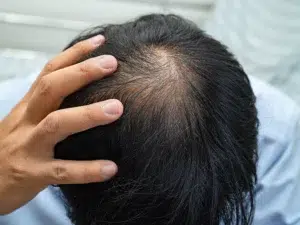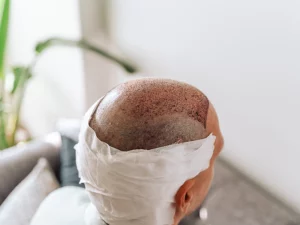“Will I Lose All My Hair with Scarring Alopecia?” It’s a question that reverberates in the minds of thousands of people who grapple with this enigmatic hair loss condition; especially for those who think hair represents more than just a collection of strands; it symbolizes their identity, confidence, and self-worth.
In this blog, we embark on a journey to demystify scarring alopecia. Remember, understanding the complexities of this condition is the first step in finding solutions.
Scarring Alopecia: What You Need to Know

Scarring alopecia, also known as cicatricial alopecia, is a group of rare hair loss disorders that cause permanent damage to hair follicles. Unlike common types of hair loss, such as male pattern baldness or alopecia areata, which are typically non-scarring and reversible, scarring alopecia results in irreversible hair loss.
What Causes It?
The underlying reason for scarring alopecia varies among individuals and may be attributed to genetics, autoimmune diseases, inflammation, or other factors.
What Are Its Main Characteristics?
The condition is characterized by the replacement of hair follicles with scar tissue, which hinders the regrowth of hair. Scarring alopecia can manifest in different forms, such as lichen planopilaris, frontal fibrosing alopecia, and central centrifugal cicatricial alopecia, each with its unique characteristics and progression.
What Is The Impact of Scarring Alopecia?
One of the most common questions individuals with this problem have is “Will I Lose All My Hair with Scarring Alopecia?”. While this condition can indeed lead to extensive hair loss, the extent and pace of hair loss vary among individuals.
Some may experience gradual thinning, while others may lose their hair more rapidly. It is essential to consult a medical professional to determine the specific diagnosis and prediction.
The Best Solution To Fix It?
For those living with scarring alopecia, hair transplants offer a ray of hope. Hair transplant procedures, such as Follicular Unit Transplantation (FUT) and Follicular Unit Extraction (FUE), have been a game-changer in the world of hair restoration. These techniques involve transplanting hair follicles from donor areas, typically the back of the head, to the affected areas.
The success of hair transplants in treating scarring alopecia largely depends on the extent of the scarring and the availability of healthy donor hair. A skilled hair restoration surgeon can assess the situation and recommend the most suitable procedure.
Rediscover Your Confidence At Capilar Hair Center
In conclusion, scarring alopecia is a challenging condition that can result in significant hair loss, but it does not necessarily mean you will lose all your hair. With advancements in hair restoration techniques, people affected by scarring alopecia have options to regain their confidence and restore their appearance.
If you or a loved one is struggling with scarring alopecia and are looking for a DHI hair technique or FUE transplant clinic, call us! At Capilar Hair Center, we have specialized in alopecia problems and hair restoration in Tijuana for more than a decade.
Also, we’ve had the privilege of seeing countless clients with scarring alopecia regain their confidence and self-esteem through our services. Read their inspiring hair transplant testimonials and convince yourself!
Your happiness and satisfaction are at the heart of what we do, and we take pride in being a part of your journey toward a brighter, more confident you.
Contact us today to learn more about our services and take the first step towards a brighter future with a new and renewed appearance.






